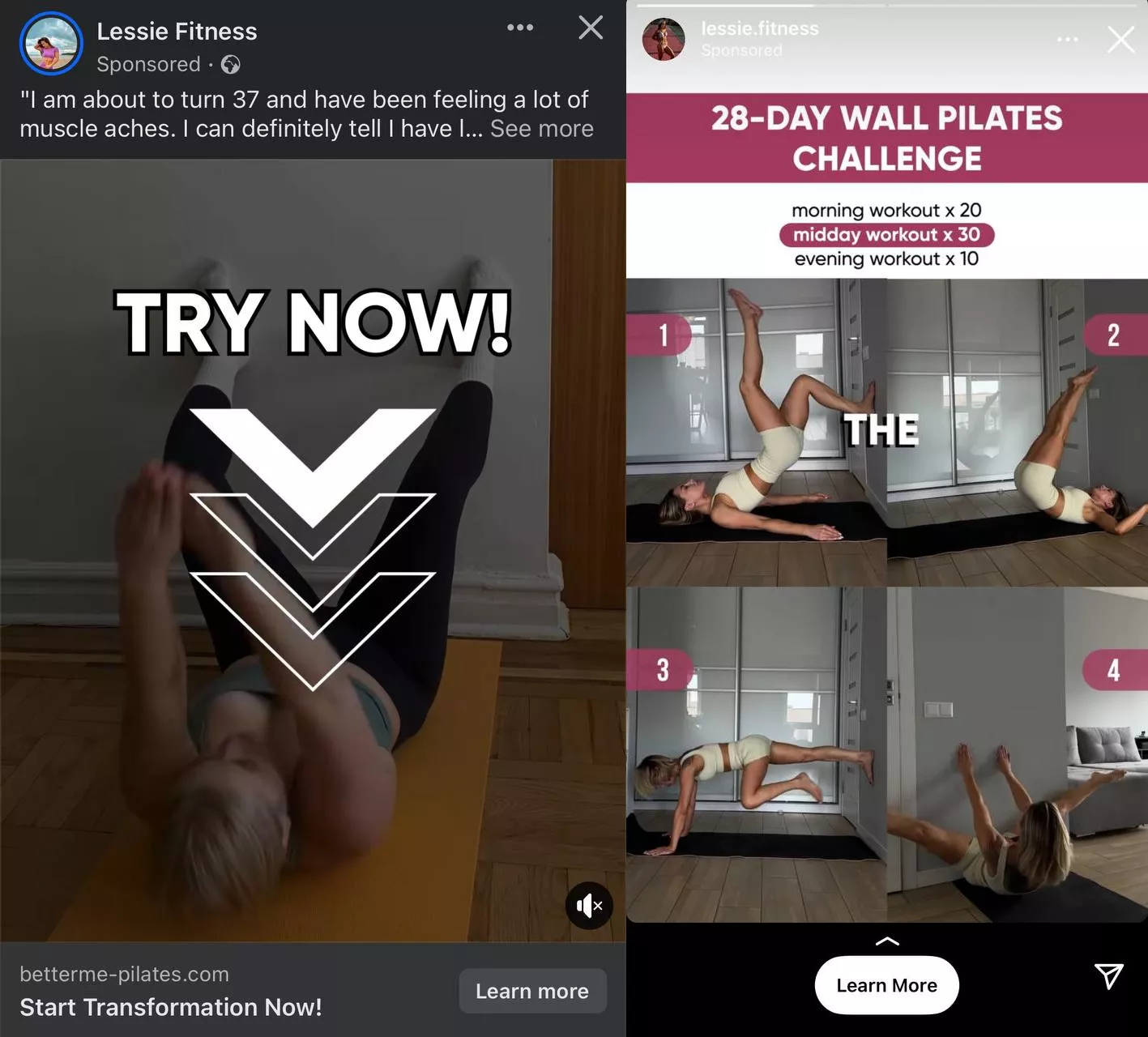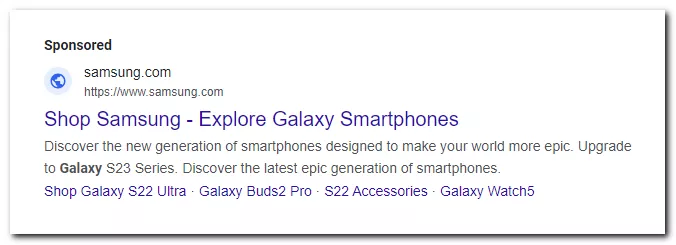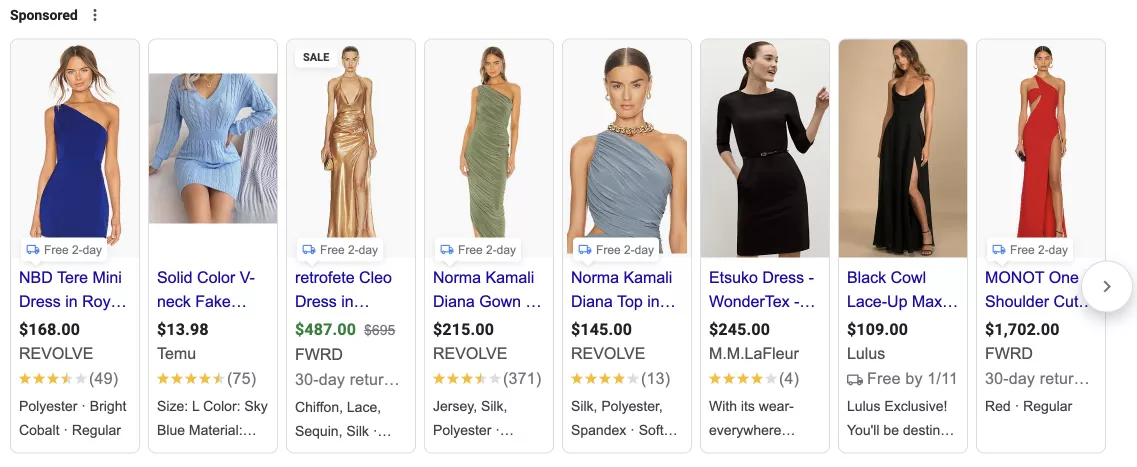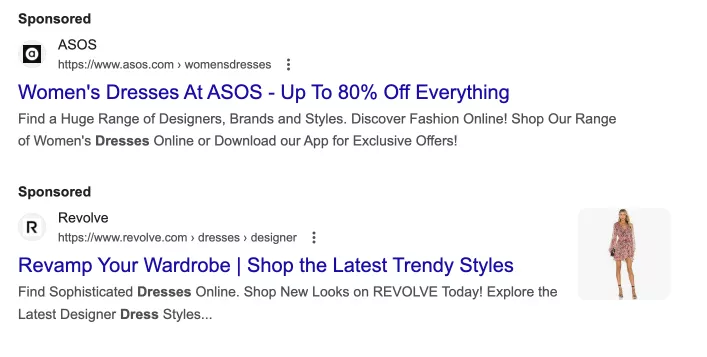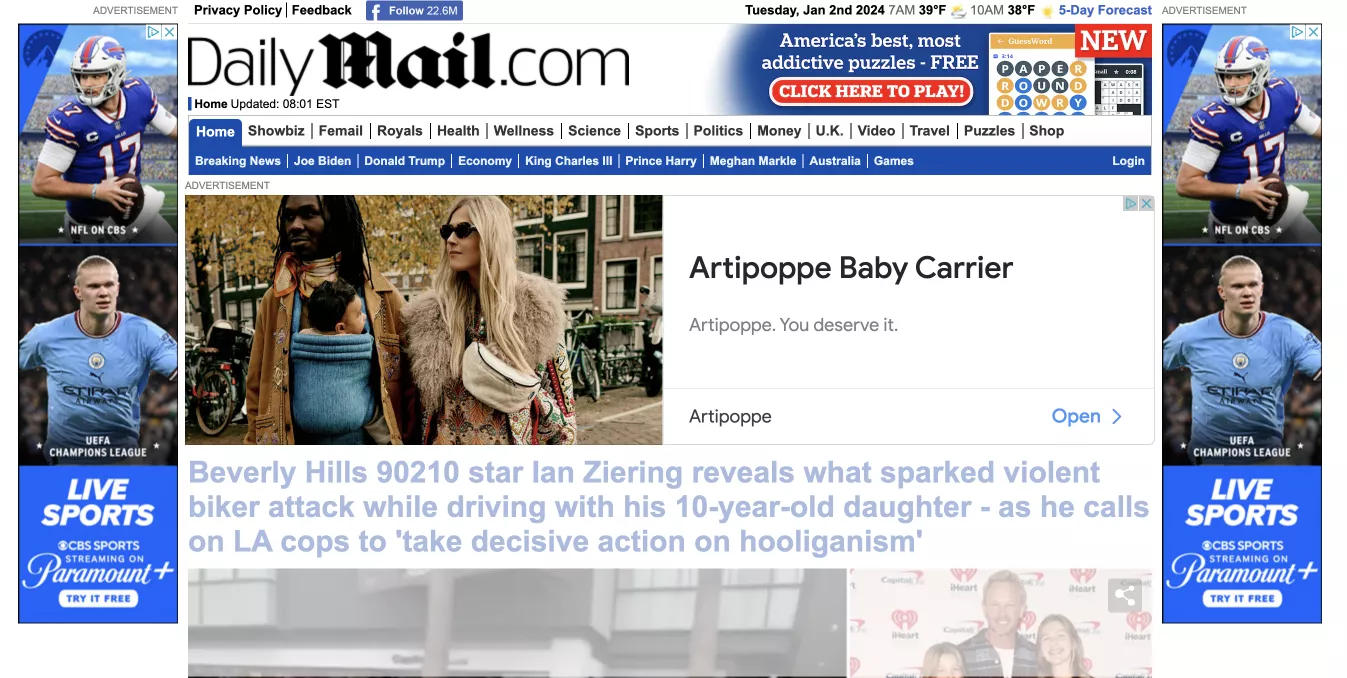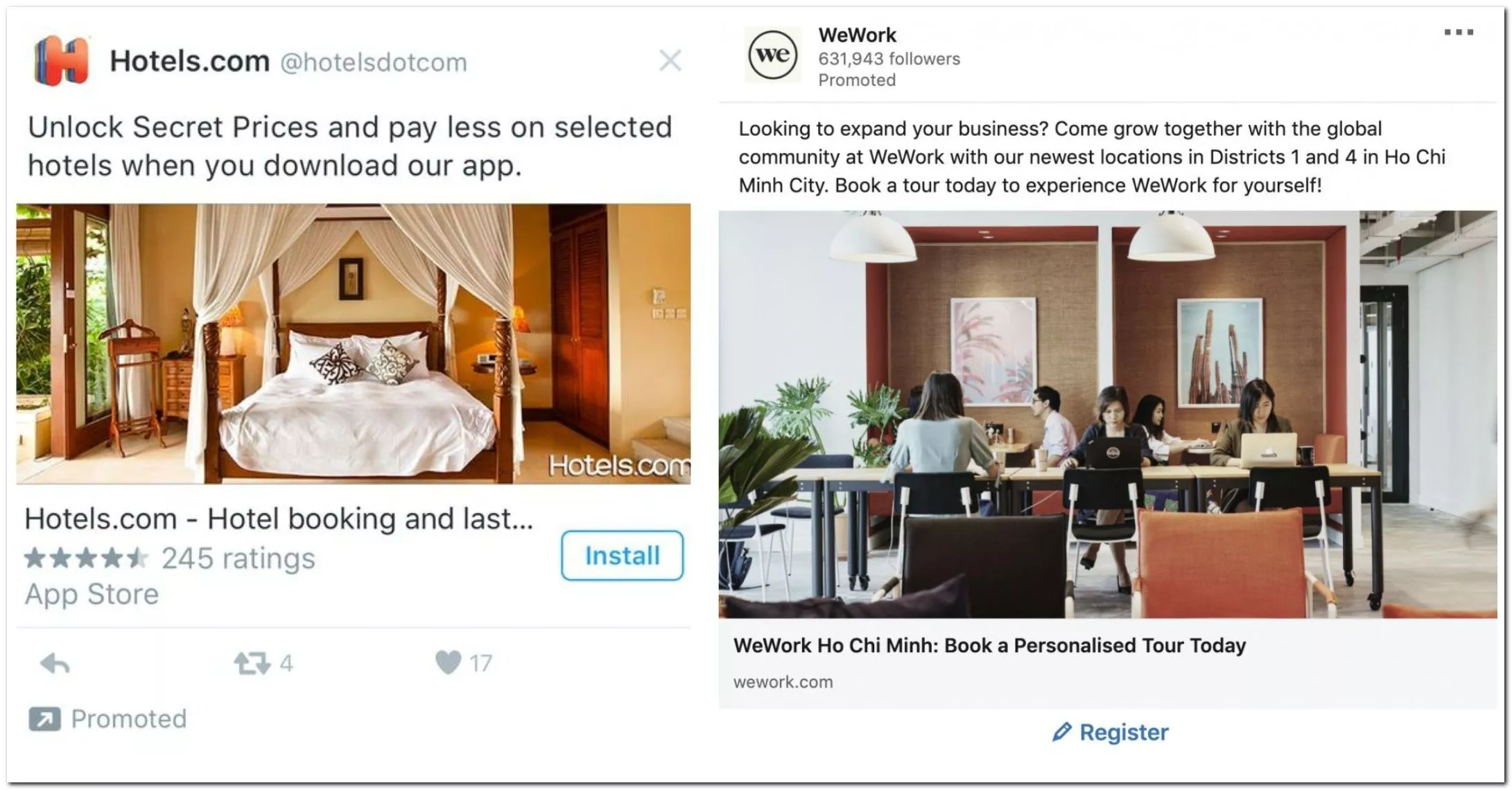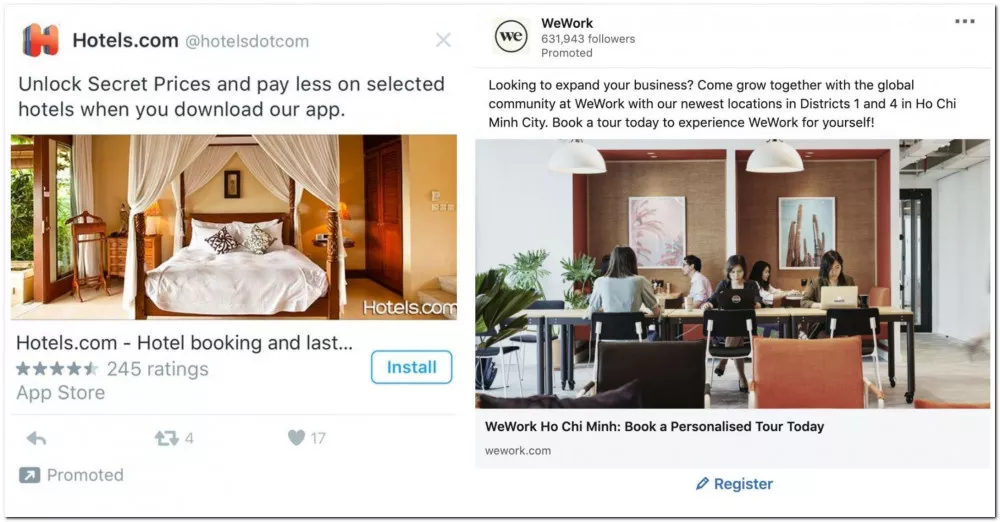PPC advertising is a commonly used term for online advertising that promotes goods and services on search or display networks. PPC advertising is also often used to refer to contextual advertising. So, what exactly is PPC?
In this article, I will dot the i's, cross the t's, and explain the essence of the pay-per-click advertising model in simple terms.
- What is the PPC model, and how does it work?
- The advantages of pay-per-click advertising
- The disadvantages of pay-per-click advertising
- Who will benefit from the PPC advertising model?
- Main types of PPC advertising
- Product advertising using the PPC model
- Search advertising using the PPC model
- Display advertising using the PPC model
- Video advertising using the PPC model
- Social media ads
- The key metrics of PPC advertising and their impact on campaign performance
- How do we measure PPC effectiveness?
What is the PPC model, and how does it work?
PPC, or pay-per-click, is an online advertising model where advertisers pay for clicks. That is, advertisers only have to pay after a user clicks on an ad.
The PPC model is used primarily in contextual advertising. That's why when people talk about contextual advertising, they often mean PPC and vice versa.
PPC in contextual advertising
Contextual advertising is a type of advertising that displays ads based on several factors. These factors help the ad system find the most relevant users. They include:
- the user's search query;
- search history;
- purchase history;
- web page visit history;
- interests and subscriptions;
- the content of the web pages on which the advertisement is displayed.
In simple terms, an ad for a laptop is most likely to be shown to a user interested in laptops, searching for a laptop, or visiting a website about computer equipment. By filtering out irrelevant users, contextual advertising increases the advertiser's chances of selling the product.
In this case, the PPC model saves money because the advertiser does not pay for ad impressions but only for clicks leading to the site or landing page.
What is an advertisement?
When a user searches for a specific keyword related to a product or service, a list of links appears on the Search Engine Results Page (SERP). Some of these links are advertisements and are marked as "Sponsored."
When it comes to social media like Facebook, TikTok, or LinkedIn, ads find their recipients based on certain matching criteria: gender, age, interests, purchase history, etc. These ads appear in the user's feed in a variety of formats.
Here is what ads look like in different ad systems:
Facebook and Instagram Stories
Google Ads
In the PPC model, the advertiser pays the advertising system, publisher, or provider for the clicks on the ad.
How is the CPC calculated, and what’s an auction?
CPC (cost per click) is usually based on an auction. This is an algorithm that determines where your ad will appear and if it will appear at all. Major ad publishers support the auction system: Google Ads, Meta Ads, LinkedIn Ads, TikTok Ads, Amazon Advertising, and others.
When a user does a search or visits a website, an internal auction starts, and ads that meet certain criteria are considered for display. The auction system typically considers the following factors: bid amount (the amount you are willing to pay per click), quality, and ad relevance.
Of course, provider companies do not disclose their auction algorithms. Each ad system only describes general recommendations for effective ad campaigns, such as choice of bidding strategy, ad quality, and targeting.
Let's take Google Ads search advertising as an example. The CPC is calculated as the result of an auction that takes into account the following factors:
- your bid for the keywords that triggered the ad;
- ad quality score, which includes the expected click-through rate (CTR), relevance to the search query, and landing page quality score;
- predicted creative and format impact, which is based on the amount of information you included in the ad;
- minimum rating of the ad and its compliance with auction requirements;
- ad context, including the user search history, place and time, device, etc.
As a result of the auction, your ad and each competitor's ad will receive an ad rank. To calculate an estimated cost per click, you should divide the rating of the competitor's ad next to yours by your quality score and add $0.01.
This rough estimate will not help you budget for ad campaigns or predict the cost per click. The real formulas are much more complex and are not disclosed by the providers. However, this calculation provides an understanding of the complexity of the algorithms and the interaction of bid and ad quality in generating cost per click.
Keep in mind: The CPC in PPC advertising is determined by a number of factors. The most important of these are the bid and quality of the ad, which are advertiser-dependent, and the competition for the ad in the auction, which is advertiser-independent. The competition reflects the situation in the market as a whole.
Well-designed ads help you win auctions because of their higher quality scores. This reduces the actual cost per click and increases the effectiveness of ad campaigns.
A brief overview of bidding strategies in the PPC advertising model
Bids are set by a PPC specialist at the time of creating an ad campaign. But before that, you need to decide on a strategy for setting bids.
A bidding strategy is a method by which an advertiser sets the maximum price they are willing to pay for a click on their ad.
There are three main types of bid strategies:
- manual
- automated
- enhanced (ECPC)
All advertising systems have these strategies in different variations.
Manual bidding is a common type of strategy where an advertiser sets the maximum bid price for each keyword or group of keywords.
This gives you more control over costs and increases your ad campaign effectiveness, positively impacting your ROI.
Automatic bidding is an intelligent bidding strategy. The maximum bid price is automatically set based on the system's algorithms for each keyword or group of keywords. The setup takes less time, but campaigns with this bidding strategy may be less effective.
Enhanced CPC is a type of automated bidding that uses historical data to adjust the maximum bid price. This increases the likelihood of getting a click on the ad.
The choice of bidding strategies depends on the advertiser's goals and budget.
Who does the advertiser pay?
The advertiser pays the providers for advertising. Providers are also known as advertising services, advertising systems, and advertising publishers. These digital platforms allow businesses to place, manage, and optimize advertising campaigns on search engines, social media, and affiliate networks.
Some popular PPC services include:
- Google Ads;
- Microsoft Ads (Bing Ads);
- Meta Ads (Facebook & Instagram);
- Twitter Ads;
- LinkedIn Ads;
- Amazon Advertising;
- Reddit Ads;
- Snapchat Ads;
- Quora Ads;
- Pinterest Ads;
- TikTok Ads.
Each platform has its own unique features and specifics, and all of them support the pay-per-click model.
What other online advertising payment models are available?
In addition to pay-per-click (PPC) advertising, there are several other payment models:
- CPM (cost per mille). In this model, the advertiser pays for every 1000 ad impressions. The price is determined based on the cost per thousand impressions, regardless of the number of clicks on the ad.
- CPA (cost per acquisition). The advertiser pays only for specific actions or conversions that are achieved. For example, a product purchase, form completion, subscription, etc.
- CPI (cost per install). This model is mainly used in mobile marketing. You pay for each installation of your mobile application that results from advertising.
- CPL (cost per lead). In this model, you pay for each registered lead or contact you receive. A lead can be generated by filling out a form, subscribing to a newsletter, etc.
Your choice of advertising model depends on your goals and the specifics of your business. For example, the CPM model is suitable for display advertising, where the goal is to increase brand awareness by showing banners to as many people as possible.
The advantages of pay-per-click advertising
Pay-per-click advertising is a fairly old and well-researched model. It dates back to the ‘90s when the Internet was not yet widespread. Now, after almost three decades of evolution and improvement, PPC has much to boast about.
Cost-effectiveness
PPC advertising only charges when a user clicks on an ad, as opposed to the CPM model, which counts the number of impressions. This approach is effective because the advertiser only spends money on potential buyers.
With a well-customized ad and a relevant landing page, advertisers have a good chance of getting their desired conversion. Of course, a visit to a website does not always lead to a purchase, but the purpose of PPC advertising is to drive the user to the desired landing page. It is then the advertiser’s responsibility to ensure high-quality content, competitive prices, and useful additional services on their website.
Performance monitoring
A PPC specialist can adjust campaign settings to improve performance by analyzing key performance indicators. The key indicators include:
- number of clicks;
- click-through rate (CTR);
- cost per click (CPC);
- number of conversions;
- conversion rate (CR);
- expenses.
For example, you can increase your bid on keywords that have high conversion rates. Or you can disable ineffective keywords to optimize your campaign performance.
Multipurpose PPC model
PPC advertising can be used at any stage of the marketing funnel, from awareness to conversion. However, the ad format, targeting, audience engagement channels, and keywords will change depending on the goal of the marketing stage.
For example, you will outline the brand theme or product category with relevant keywords at the brand discovery stage. Whereas at the engagement stage, the keywords are fully relevant to the product range to attract an interested audience.
Marketplaces also use the PPC advertising model. To learn more about this, read our article: The eBay Marketplace, and How to Advertise Products on It
The disadvantages of pay-per-click advertising
PPC advertising has drawbacks, which should be considered before launching PPC ad campaigns.
High competition and cost
One of the biggest challenges with PPC advertising is the intense competition for popular keywords and ad placements. As more companies use PPC advertising, the cost per click for competitive keywords increases.
It can be challenging to achieve a positive ROI on a limited budget. You must carefully manage your bids and budgets to get the most out of your ad campaigns.
Clicks ≠ conversions
While the PPC model drives traffic to the advertiser's website, it does not guarantee conversions.
If landing pages or website content are not optimized for conversions, advertisers may have a high click-through rate (CTR) but a low conversion rate (CR). To increase the likelihood of conversions, it's important to have attractive ads, relevant landing pages, and clear calls to action.
Advertisers should continuously monitor and optimize their landing pages to increase conversion rates and maximize ROI.
Complexity and HR costs
Running a successful campaign takes time, effort, and experience. Advertisers must:
- collect relevant keywords;
- write an effective text ad;
- monitor expenses;
- adjust bids;
- optimize campaigns on a regular basis.
These require knowledge of contextual advertising and skills in content marketing, targeting, and analytics. Rather than trying to do everything yourself, it is better to seek out professional digital marketing agencies.
Who will benefit from the PPC advertising model?
There are certain types of businesses that would especially benefit from the pay-per-click advertising model.
E-commerce campaigns
E-commerce advertisers can promote products to potential customers through product advertising, search advertising, remarketing, and display advertising. The PPC model helps advertisers use the budget efficiently, control traffic to the site, and increase brand awareness.
For example, to boost the sales of a new shoe collection, an advertiser can use product ads and adjust CPC bidding for relevant keywords.
SaaS businesses
SaaS (Software as a Service) companies can use PPC to find a relevant audience looking to solve specific problems with software solutions. By attracting users through targeted or search advertising, the advertiser increases their chances of receiving applications on the site.
Local businesses
Businesses that operate in specific regions can target their ads to users in that region. This increases the chances of attracting customers from nearby locations.
Companies with high customer LTV
LTV (customer lifetime value) is the lifetime value of a customer. If a company offers goods or services that bring customers back repeatedly, such as dentistry, delivery services, and telephony, it guarantees a high LTV.
As these are not impulsive purchases, a customer is likely to carefully study the information when choosing such products or services.
By preparing ads relevant to search queries, high-LTV companies will attract only interested users and weed out those who are not interested in the product. For these companies, the downside to the PPC model is potentially high CPCs.
High-margin services and products
PPC is suitable for businesses that need only one conversion from a customer (the LTV is not important) and have high margins for their service or product. For such services or products, you should set up search PPC advertising with relevant keywords.
For example, it can be the services of a lawyer, car repair or sale, or real estate. Normally, the cost per click for such goods and services is significant, but these costs are offset by high business margins.
Rare products
If the advertiser's product is difficult to find offline, users will search for it online. In this case, it is worth investing in PPC advertising for relevant keywords, considering the audience's interests.
Main types of PPC advertising
Depending on the campaign goals and business specifics, the types of ads listed here can support not only PPC but also other payment models.
Product ads
Product ads appear on the search engine results page as product thumbnails with a price:
Designed to promote specific products, product ads are typically used by e-commerce companies to drive sales. Users can browse and compare the company's product offerings without having to visit the website, so advertisers don't have to pay for clicks of interest. Instead, they get more engaged customers who are more likely to purchase.
Product advertising can take a variety of forms, including:
- banner ads on websites;
- search engine or social media ads;
- video ads on streaming platforms;
- advertising messages in mobile applications.
One of the most important examples of product advertising with a pay-per-click model is Google Shopping, where advertisers can display their products on search result pages. Users can then click on the ad to go directly to the product page.
Such advertising helps you keep track of other offers in the market, adjust product prices, or change bids to beat competitors. It also increases your visibility in search results.
To set up product advertising, you need to upload a product feed. This document contains a complete list of all products for sale as well as their descriptions, features, identifiers, prices, and links. The advertising system will display products from the feed in user search results or on social media pages.
Search ads
These are ads on search engines, such as Google or Bing. Text ads appear at the top or bottom of the search results page. These ads are labeled "Ad," "Sponsored," or "Promoted".
Search ads have titles, descriptions, landing page URLs, and additional elements that describe the benefits of a product or service and encourage conversion. All ad texts should be consistent with the content of the landing page the customer will go to.
Remember, advertising helps drive traffic to a website, but it does not guarantee conversion.
The results of search advertising are influenced by keywords, ads, bids, and budget. Other important settings include geo-targeting, audience segments, and ad tracking tags.
Display advertising
Display advertising involves placing graphic ads on various websites:
These can be static banners of various formats or dynamic ones (for example, HTML5), titles, descriptions, and additional information. The PPC model in this type of advertising works similarly to search advertising: advertisers pay only for clicks on banner ads.
It is worth noting that display advertising is usually associated with the cost-per-1000 impressions (CPM) model. If the advertiser's goal is brand awareness, exposure, and presence, the number of clicks does not matter.
However, if the goal is to drive traffic to the site and get a specific conversion action from the user, you should use the pay-per-click (PPC) model.
The most important thing about PPC display advertising is the audience. The actual cost of the ad depends on its settings because the wider the audience, the less relevant it is.
By specifying the interests, age, etc., of your target audience in the campaign settings, you can weed out those who are definitely not interested in your product or service and get a warmer audience.
For example, not everyone in the USA needs strollers. Young parents, people who look for and buy baby clothes, and people who read articles about newborn care or pregnancy are the ones who might want to purchase strollers. This is the audience you should target with your stroller sales media campaign.
With the PPC model, you get meaningful interaction with the ad and only pay for clicks that potentially convert into purchases.
Video advertising
Video ads are promotional video content posted on social media, video hosting sites, etc. They can be integrated into other videos, such as those on Facebook, TikTok, or LinkedIn.
There are many formats for video ads. They vary by advertising system, campaign objective, and even device type. This type of advertising uses several payment models, including CPV, PPV, CPM, and CPM.
Not all advertising systems offer pay-per-click in video ads. For example, Google Ads does not have this setting.
In addition to targeting (focusing on a specific audience), the quality and content of the video are extremely important factors. In a video, an advertiser can convey more information in a short amount of time than, say, in a search ad. So, be sure to deliver the most important message or call to action in the first few seconds of the video.
Not only that, each ad system requires a unique approach to video advertising and different ad settings. For instance, about 95% of YouTube videos are watched with sound on, and 85% of Facebook users prefer to watch videos without sound.
Social media ads
These are ads on social media platforms like Facebook, Instagram, Twitter, LinkedIn, TikTok, etc. Ads appear in news feeds, search results, sidebars, and more:
As with display advertising, targeting plays an important role in the effectiveness of pay-per-click advertising. It’s no surprise that social media advertising is often referred to as social media targeting.
When setting up a campaign, advertisers should specify audience interests, demographic and behavioral characteristics, occupations, and more. Careful audience targeting allows the system to show ads to those who are likely to be interested, and the advertiser only pays for interaction.
The key metrics of PPC advertising and their impact
Here's a glossary of the most important PPC advertising metrics, with formulas and examples. These metrics are used in ad service analytics and by PPC professionals to evaluate the effectiveness of advertising.
Cost per click (CPC) is the actual cost of each click. It determines how much an advertiser will pay for a click on an ad. It is important to distinguish between the CPC bid and the actual CPC; the former depends on your budget and campaign settings, and the latter is the actual average cost of one click on your ad.
This metric helps you understand the cost of traffic and the efficiency and profitability of your advertising efforts.
CPC = Total Ad Spend / Number of clicks
For example, if you spend $100 on advertising and receive 10 clicks, the CPC will be 100 / 10 = $10 per click.
Clicks mean the number of times users click on an ad.
CTR (click-through rate) measures the percentage of users who saw and clicked on an ad. This metric gives you an idea of your advertising effectiveness. A low CTR means that your ad is not relevant to the user.
CTR = (Total clicks / Total impressions) * 100%
For example, if your ad had 1000 impressions and received 50 clicks, the CTR would be (50 / 1000) * 100% = 5%.
Cost per acquisition (CPA) is the conversion cost incurred by a user or the cost of acquiring a new customer. A high CPA means that the campaign is not working efficiently and needs to be optimized.
CPA = Total Ad Spent / Number of Conversions
For example, if you spent $500 on advertising and received 20 conversions, the CPA would be $500 / 20 = $25 per conversion.
Cost / Amount spent / Spent is the amount paid by the advertiser for clicks, conversions, impressions, views, etc.
Conversions are the number of conversions (targeted actions) an advertiser receives on a website.
Conversion rate is the percentage of users who performed the desired action (purchase, form completion, subscription, etc.) after visiting the site. This indicator allows us to evaluate if the ad content is relevant to the site content, price offer, product usability, etc.
Conversion Rate = (Number of Conversions / Total Visitors) * 100%
For example, if 100 visitors clicked on your ad and 10 of them made a purchase, the conversion rate would be (10 / 100) * 100% = 10%.
Impressions are the number of times your ad is shown to users.
Search Impression Share is the number of impressions you've received on the search network divided by the estimated number of impressions you were eligible to receive.
Search Impression Share = (Your Impressions / Total Impressions) * 100%
For example, if your ad was shown 800 times and the total number of possible impressions is 1000, your search IS would be (800 / 1000) * 100% = 80%. This means that, for some reason, you lost 20% of the potential impressions.
Lost Impression Share due to Rank is the percentage of impressions that are lost due to a low-ranking ad in search engine results. It shows how many impressions your ads did not receive.
Lost Impression Share due to Rank = (Number of Lost Impressions due to Rank / Number of Possible Impressions) * 100%
For example, if you lost 200 impressions due to low ranking, and the total number of possible impressions is 1000, the percentage of impressions lost due to ranking would be (200 / 1000) * 100% = 20%.
Lost Impression Share due to Budget is the percentage of impressions that are lost due to a limited ad budget or an incorrectly set CPC rate.
A high percentage of impressions lost due to budget indicates an inefficient campaign and the need for immediate optimization, which does not necessarily mean increasing the budget. Each element should be considered in context: the market situation, other ad campaigns, competitor activity, recent changes in settings, etc.
Lost Impression Share due to Budget = (Number of Impressions Lost Due to Budget / Number of Possible Impressions) * 100%
For example, if you lost 150 impressions due to a limited budget, and the total number of possible impressions is 1000, the percentage of impressions lost due to the budget would be (150 / 1000) * 100% = 15%.
How do we measure PPC effectiveness?
There are special metrics to evaluate the effectiveness of PPC advertising. Most of them have been covered in the previous section, but I'll discuss the most important ones here: ROI, ROMI, and ROAS.
These metrics allow you to evaluate the profits from your advertising investment, the performance of advertising channels or campaigns, and the general profitability of your business.
ROI, ROMI, and ROAS are related and often used interchangeably. However, some differences are important to understand.
ROI (Return on Investment) is used to evaluate the effectiveness of an investment. It determines how much profit an advertising campaign has generated in relation to the funds invested. By calculating the ROI, advertisers can assess the profitability of their advertising campaigns.
ROI is more commonly used to calculate the profitability of a business in general. For example, let’s say you have an online store selling mobile phone cases. In September, you sold 1,000 cases for $20 each (the cost value of one product is $5). You spent $2,500 on a product ad campaign, and your employees' salaries, taxes, and other operating expenses came to a total of $3,000.
ROI: (Income - Expenses) / Total Investment * 100%
Let's first define income and expenses:
Income = 1,000 * $20 = $20,000
Expenses = 1,000 * $5 + $2,500 + $3,000 = $10,500
ROI = (20,000 - 10,500) / 10,500 * 100% = 90%
This means that the business is profitable. However, the owner may not be satisfied with this profitability, so they need to work on increasing it. If the ROI is >0%, this is already a positive dynamic, which means that you have passed the break-even point. An ROI of <0% means the business is unprofitable.
To improve your ROI, review your business goals and the relevance of your target audience. Disable unprofitable advertising channels and reallocate your budget. The metrics described in the section above will help you do this.
ROMI (Return on Marketing Investment) measures the effectiveness of marketing spend and helps determine the success of advertising efforts.
ROMI estimates how much you get from the amount you have invested in marketing. You can use this metric to evaluate the effectiveness of different sales channels. Note that only marketing expenses are included in the ROMI calculation.
For example, let’s say you sell sweatshirts. When you bought them, each sweatshirt cost you $30. The selling price is $80. In August, you decided to try product ads on Google Ads and Facebook, for which you spent $2,500 and $2,000, respectively. As a result, in one month, you sold 200 sweatshirts through Google Product Ads and 220 through Facebook.
Let's calculate the ROMI for August.
ROMI: (Marketing revenue - Marketing expenses) / Marketing expenses * 100%.
Let's define marginality, the percentage of profit in relation to the cost of products, profit, and expenses:
Margin = ($80 - $30) / $80 * 100% = 62%
Marketing revenue = (200 + 220) * $80 * 62% / 100 = $20,832
Marketing expenses = $2,500 UAH + $2,000 UAH = $4,500
ROMI = ($20,832 - $4,500) / $4,500 * 100% = 362%.
Your advertising is profitable. If the ROMI is 100%, the ad has no revenue. If the ROMI is <100%, your advertising is unprofitable.
To improve ROMI, you need to analyze this indicator for different advertising channels and quickly reallocate the budget in favor of channels with a higher return on investment. You should also optimize your advertising campaigns:
- check the keyword relevance;
- add new keywords and phrases from time to time;
- monitor the usability of your website;
- update creatives, etc.
ROAS (Return on Advertising Spend). This metric is useful for evaluating the effectiveness of a particular advertising campaign or channel. It reflects the return on investment for the costs spent on a particular advertising activity. Let's calculate the ROAS for the same online sweatshirt store and compare the ROI for each channel.
ROAS: Ad Revenue / Ad Cost * 100%.
ROAS for Google Ads = 200 * $80 / $2,500 * 100% = 640%
ROAS for Facebook = 220 * $80 / $2,000 UAH * 100% = 880%
If the ROAS is >100%, the advertising efforts are successful. If ROAS is exactly 100%, the advertising has worked just enough to reach the break-even point. If the ROAS is <100%, advertising is not profitable for the campaign or channel.
To improve ROAS, you should constantly monitor campaign performance and adjust your budget and bids to achieve the optimal ROI. Stop campaigns that don't produce timely results and improve the quality of those that show higher ROAS.
Improvements can be made by checking the relevance of semantics, ads, and landing pages and updating the creatives.
Read more about ad monetization services and campaign optimization in our Netpeak Journal:
- Performance Max Campaign Optimization: 10 Steps to Maximize Efficiency
- Google Ads Match Types: The Ultimate Guide
- Building a Keyword List: A Comprehensive Guide for Ecommerce Websites
Conclusions
1. PPC, or pay-per-click, is an online advertising model in which advertisers pay for clicks. Essentially, they only pay when a user clicks on an ad.
2. The cost per click (CPC) is most often calculated every time the auction runs, and there is an algorithm that determines where your ad will appear if it will appear at all. Google Ads, Facebook, LinkedIn, TikTok, YouTube, Amazon, and other ad providers support the auction system.
3. The main advantage of the PPC advertising model is its cost-effectiveness and performance control. Advertisers pay only for clicks, so they can evaluate key campaign indicators at any time and make changes quickly. However, PPC campaigns are highly competitive, resulting in a high CPC, and campaign performance needs to be constantly monitored.
4. The PPC advertising model is suitable for almost all businesses because it is cost-effective and flexible. Most existing advertising systems offer the ability to manually set bids for PPC. The manual bidding strategy is the most effective because it is easily controlled by the advertiser and works transparently, unlike automated strategies.
5. We can evaluate the effectiveness of PPC advertising using the following metrics:
- CPC;
- Clicks;
- CTR;
- Conversion Rate;
- Search Impression Share;
- Lost Impression Share due to Budget;
- ROI;
- ROMI;
- ROAS.
Each of these metrics is interdependent. By changing the cost per click, you affect the number of clicks and conversions, which affects the final ROI of your advertising.
6. The best PPC advertising system for you depends on your business goals, budget, and target audience. Tell us about your business, and Netpeak Agency specialists will examine your application and offer the most effective tools to promote your business.
Related Articles
How to Set Up Consent Mode in GA4 on Your Website with Google Tag Manager
Let's explore how to properly integrate consent mode in GA4, configure it for effective data collection, and at the same time comply with GDPR and other legal regulations
Display Advertising Effectiveness Analysis: A Comprehensive Approach to Measuring Its Impact
In this article, I will explain why you shouldn’t underestimate display advertising and how to analyze its impact using Google Analytics 4
Generative Engine Optimization: What Businesses Get From Ranking in SearchGPT
Companies that master SearchGPT SEO and generative engine optimization will capture high-intent traffic from users seeking direct, authoritative answers

